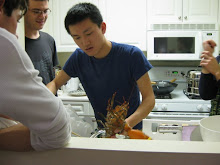So, last night, I decided to prepare a few of the oyster canapés in the French Laundry Cookbook.
The first that I will write about is Pickled Oysters with English Cucumber "Capellini" and Dill. (So I lied. I actually started this the night before).
Anyways, the night before, I started prep work on this beautiful recipe. Here is my mise en place:
 Dill, sugar, white wine vinegar, water, cloves, coriander seed, and star anise.
Dill, sugar, white wine vinegar, water, cloves, coriander seed, and star anise.I put this into a small sauce pan and simmered gently.
 Next, I shucked the oysters. I got the oysters from Wild Edibles Market. I asked for the meatiest oysters they had. They suggested Umamis from Rhode Island. When I asked the fishmonger whether or not they were as meaty as [insert other type of oyster here], she shucked one in front of me, handed it to me, and said, "Eat it."
Next, I shucked the oysters. I got the oysters from Wild Edibles Market. I asked for the meatiest oysters they had. They suggested Umamis from Rhode Island. When I asked the fishmonger whether or not they were as meaty as [insert other type of oyster here], she shucked one in front of me, handed it to me, and said, "Eat it."I did, and that sealed the purchase. Here they are in all their glory:
 I shucked them (and ate a few while shucking them too -- I'm a sucker for raw oysters), and separated the oysters and the cleaned and scrubbed shells.
I shucked them (and ate a few while shucking them too -- I'm a sucker for raw oysters), and separated the oysters and the cleaned and scrubbed shells. Next, I put the oysters into the pickling liquid and stored this in my refrigerator.
Next, I put the oysters into the pickling liquid and stored this in my refrigerator. A side view:
A side view: The next day, I went and purchased a large English cucumber. Look at this baby:
The next day, I went and purchased a large English cucumber. Look at this baby: English cucumbers are often sold in specialty groceries, not your standard Whole Foods or whatever. They are also sold as "seedless cucumbers" and are often wrapped in plastic wrap, whole. I have read that the English cucumber has fewer seeds, and the skin can even be eaten raw (and not affect the taste too much).
English cucumbers are often sold in specialty groceries, not your standard Whole Foods or whatever. They are also sold as "seedless cucumbers" and are often wrapped in plastic wrap, whole. I have read that the English cucumber has fewer seeds, and the skin can even be eaten raw (and not affect the taste too much).Anyhoo, I took out my trusty mandolin and julienned 1/16th inch strips. They sort of resemble cannelloni, don't they?
 I soaked this for 30 minutes in rice wine vinegar and some chopped dill.
I soaked this for 30 minutes in rice wine vinegar and some chopped dill.
I strained this, pushing the liquid out. I then tossed it with some fresh dill and started the plating process.
Next: Plating! The book recommends serving on top of either a bed of seaweed or a bed of special salt mixture. The latter was WAY too expensive as it called for three cups of salt mixture (or more). I only checked one store for salt, but they only had one type of rock salt and it was $15 a bag. The other salts they had were way too fine to use. I also tried looking for fresh seaweed everywhere to no success. Every time I asked a grocery store attendant whether they had fresh seaweed, they directed me to the Asian dry goods aisle. Ugh.
Anyway, at the Manhattan Fruit Exchange, I was lucky enough to find sea beans.
First, a "nest" of sea beans:

Next, a clean oyster shell:

Now, some "cannelloni":
 Then a pickled oyster:
Then a pickled oyster: A small sprig of dill:
A small sprig of dill: Finally, top with some Osetra caviar. This was probably the most expensive portion of the dish, at $65/ounce. I got the California type since I'm a cheapskate.
Finally, top with some Osetra caviar. This was probably the most expensive portion of the dish, at $65/ounce. I got the California type since I'm a cheapskate. I served this to three guests and myself.
I served this to three guests and myself. What can I say? Aside from the intense effort to find all the right ingredients, it was actually one of the easiest recipes I have made in the cookbook, requiring only a few steps and no actual heat from the stove.
What can I say? Aside from the intense effort to find all the right ingredients, it was actually one of the easiest recipes I have made in the cookbook, requiring only a few steps and no actual heat from the stove.I enjoyed the flavor very much. The pickled flavor from the oyster intensified the salty, briny umami flavor of the oyster. The dill completed the oyster flavor as well. The caviar provided slight salinity. The soft texture of the oyster was complemented by the slight crunchiness of the cucumber whereas the caviar provided a slippery delicate texture, with the extraordinary "pop!" that came every so often when chewing. There were so many flavors and textures in this dish. And of course, everyone loved it and asked for seconds (and in some cases, thirds).
This is definitely going on the rotating kitchen menu.
Sources:
Sea beans from Manhattan Fruit Exchange (Chelsea Market)
Umami oysters (RI) from Wild Edibles
Osetra caviar from Pescatore
English cucumber from Food Emporium
Produce and other items from Whole Foods



wow! that looks amazing!
ReplyDelete